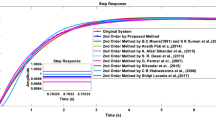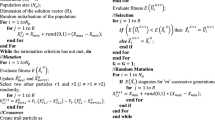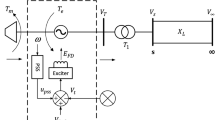Abstract
This study presents a novel approach for the simplification and controller design of expansive dynamic linear time-invariant plants. This approach applies to both single input single output and multiple input multiple output models on a wide scale. The diminution approach is a straightforward method that guarantees the stability of the lower-order plant, given that the higher-order system is stable. Implementing the balanced truncation approach determines the denominator polynomial of the required system. The coefficients of the numerator polynomial are computed using a simple mathematical procedure, as outlined in the suggested scenario. The proposed method overcomes the constraints of the balanced truncation scheme while maintaining its crucial attributes, including stability, controllability, observability, passivity, etc. The strategy that has been developed guarantees the preservation of stability, time moments, Markov parameters, and other features of the higher-order plant in the reduced model. A two-input, two-output, single-machine infinite bus real-time power system model and a ninth-order system are utilized to test the accuracy and effectiveness of the proposed method. The findings of the suggested technique are compared against other popular algorithms. Furthermore, controllers are derived using the moment-matching process using the recommended lower-order plant for two real-time case studies. The controller’s design is shown, and its efficacy is confirmed using a real-time system described in the literature.











Similar content being viewed by others
References
Datta B N 2005 Numerical methods for linear control systems. Elsevier Academic Press, California
Antoulas A C 2005 Approximation of large-scale dynamical systems. SIAM, Philadelphia
Fortuna L, Nunnari G and Gallo A 1992 Model order reduction techniques with applications in electrical engineering. Springer, London
Huang C, Zhang K, Dai X and Tang W 2013 A modified balanced truncation method and its application to the model reduction of power system. In: Proceedings of the 2013 IEEE Power and Energy Society General Meeting, 21–25 July, pp. 1–5. IEEE
Ramirez A, Sani A M, Hussein D, Matar M, Rahman M A, Chavez J J, Davoudi A and Kamalasadan S 2016 Application of balanced realizations for model-order reduction of dynamic power system equivalents. IEEE Trans. Power Del. 31(5): 2304–2312
Koronaki E D, Gkinis P A, Beex L, Bordas S P A, Theodoropoulos C and Boudouvis A G 2019 Classification of states and model order reduction of large-scale chemical vapour deposition processes with solution multiplicity. Comput. Chem. Eng. 121: 148–157
Mustafa D and Glover K 1990 Controller reduction by H-inf balanced truncation. IEEE Trans. Auto. Cont. 1- 31
Avadh P, Kumar A and Chandra D 2014 Suboptimal control using model order reduction. Chin. J. Eng.. https://doi.org/10.1155/2014/797581
Pal J 1980 Suboptimal control using Pade approximation techniques. IEEE Trans. Auto. Cont. 25(5): 1007–1008
Prajapati A K and Prasad R 2021 A novel order reduction method for linear dynamic systems and its application for designing PID and lead/lag compensators. Trans. Inst. Meas. Contr. 43(5): 1226–1238
Prajapati A K, Rayudu V G D and Prasad R 2020 A new technique for the reduced-order modelling of linear dynamic systems and design of controller. Circ. Syst. Signal. Process. 39: 4849–4867
Prajapati A K and Prasad R 2020 A new model order reduction method for the design of compensator by using moment matching algorithm. Trans Inst. Meas. Contr. 42(3): 472–484
Prajapati A K and Prasad R 2020 A New model reduction method for the linear dynamic systems and its application for the design of compensator. Circ. Syst. Signal. Process. 39: 2328–2348
Jain S and Hote Y V 2021 Order diminution of LTI systems using modified big bang big crunch algorithm and pade approximation with fractional order controller design. Inter Jour. Cont. Autom. Syst. 19(4): 2105–2121
Prajapati A K and Prasad R 2022 A new model reduction technique for controller design by using moment matching algorithm. IETE Tech. Rev. 39(6): 1419–1440
Prajapati A K and Prasad R 2022 A new generalized pole clustering-based model reduction technique and its application for design of controllers. Circ. Syst. Signal. Process. 41: 1497–1529
Prajapati A K and Prasad R 2023 A new model reduction technique for the simplification and controller design of large-scale systems. IETE J. Res.. https://doi.org/10.1080/03772063.2022.2163929
Shamash Y 1974 Stable reduced-order models using Pade´-type approximation. IEEE Trans. Aut. Cont. 19(5): 615–616
Hutton M and Friedland B 1975 Routh approximations for reducing order of linear, time-invariant systems. IEEE Trans. Aut. Cont. 20(3): 329–337
Chen T C, Chang C Y and Han K W 1979 Reduction of transfer functions by the stability-equation method. J. Frankl. Inst. 308(4): 389–404
Sinha A K and Pal J 1990 Simulation-based reduced order modelling using a clustering technique. Comput. Electr. Eng. 16(3): 159–169
Singh J, Vishwakarma C B and Chattterjee K 2016 Biased reduction method by combining improved modified pole clustering and improved Pade´ approximations. Appl. Math. Model. 40(2): 1418–1426
Sikander A and Prasad R 2017 A new technique for reduced-order modelling of linear time-invariant system. IETE J. Res. 63(3): 316–324
Prajapati A K and Prasad R 2019 Reduced-order modelling of LTI systems by using Routh approximation and factor division methods. Circ. Syst. Signal. Process. 38(7): 3340–3355
Sikander A and Prasad R 2015 Linear time-invariant system reduction using a mixed methods approach. Appl. Math. Model. 39(16): 4848–4858
Komarasamy K, Albhonso N and Gurusamy G 2011 Order reduction of linear systems with an improved pole clustering. J. Vibr. Cont. 18(12): 1876–1885
Singh V P, Chauhan D P S, Singh S P and Prakash T 2017 On time moments and markov parame-ters of continuous interval systems. J. Circuits Syst. Computers. 26(3): 1–7
Chuang S C 1970 Application of continued-fraction method for modelling transfer functions to give more accurate initial transient response. Electr. Lett. 26(6): 861–863
Parthasarathy R and John S 1978 System reduction using Cauer continued fraction expansion about s = 0 and s = ∞ alternately. Electr. Lett. 14(8): 261–262
Parthasarathy R and Jayasimha K N 1982 System reduction using stability-equation method and modified Cauer continued fraction. Proc. IEEE 70(10): 1234–1236
Pal J 1983 Improved Pade approximants using stability equation method. Electr. Lett. 11(19): 426–427
Moore B C 1981 Principal component analysis in linear systems: controllability, observability, and model reduction. IEEE Trans. Auto. Cont. 28(1): 17–32
Pernebo L and Silverman L 1982 Model reduction via balanced state space representations. IEEE Trans. Autom. Cont. 27(2): 382–387
Sreeram V and Agathoklis P 1989 Model reduction using balanced realizations with improved low frequency behaviour. Syst. Control Lett. 12(33–38): 1989
Prajapati A K and Prasad R 2018 Model order reduction by using the balanced truncation and factor division methods. IETE J. Res. 65(6): 827–842
Prajapati A K and Prasad R 2019 Order reduction in linear dynamical systems by using improved balanced realization technique. Circuits Syst. Signal Process. 38: 5289–5303
Prajapati A K and Prasad R 2022 Model reduction using the balanced truncation method and the Padé approximation method. IETE Tech. Rev. 39(2): 257–269
Duddeti B B 2023 Approximation of fractional-order systems using balanced truncation with assured steady-state gain. Circuits Syst. Signal Process 42: 5893–5923
Duddeti B B 2023 Order reduction of large-scale linear dynamic systems using balanced truncation with modified Cauer continued fraction. IETE J. Educ.. https://doi.org/10.1080/09747338.2023.2178530
Prajapati A K and Prasad R 2021 A novel order reduction method for linear dynamic systems and its application for designing of PID and lead/lag compensators. Trans. Inst. Meas. Contr. 43(5): 1226–1238
Prajapati A K and Prasad R 2022 Reduction of linear dynamic systems using generalized approach of pole clustering method. Trans. Inst. Meas. Contr. 44(9): 1755–1769
Obinata G and Inooka H 1983 Authors reply to comments on model reduction by minimizing the equation error. IEEE Trans. Autom. Contr. 28(1): 124–125
Eitelberg E 1981 Model reduction by minimizing the weighted equation error. Int. J. Control 34(6): 1113–1123
Salah K 2017 A novel model order reduction technique based on artificial intelligence. Microelectron. J. 65: 58–71
Alsmadi O M, Abo-Hammour Z S and Al-Smadi A M 2012 Robust model order reduction technique for MIMO systems via ANN-LMI-based state residualization. Int. J. Circuit Theory Appl. 40(4): 341–354
Abu-Al-Nadi D I, Alsmadi O M, Abo-Hammour Z S, Hawa M F and Rahhal J S 2013 Invasive weed optimization for model order reduction of linear MIMO systems. Appl. Math. Mode. 37(6): 4570–4577
Alsmadi O, Al-Smadi A and Gharaibeh E A 2019 Firefly artificial intelligence technique for model order reduction with substructure preservation. Trans. Inst. Meas. Contr. 41(10): 2875–2885
Duddeti B B, Naskar A K and Subhashini K R 2023 Order reduction of LTI systems using balanced truncation and particle swarm optimization algorithm. Circuits Syst. Signal Process. 42: 4506–4552
Vasu G, Sivakumar M and Ramalingaraju M 2020 Optimal model approximation of linear time-invariant systems using the enhanced DE algorithm and improved MPPA method. Circ. Syst. Signal. Process 39: 2376–2411
Lucas T N 1984 Biased model reduction by factor division. Electr. Lett. 20(14): 582–583
Peterson W C and Nassar A H 1978 On the synthesis of optimum linear feedback control systems. J. Frankl. Inst. 306(3): 237–256
Towill D R 1970 Transfer function techniques for control engineers. 1stedn.London: IliffeBooksLtd
Jamshidi 1998 Large-scale systems: modeling, control, and fuzzy logic, first edit. Upper Saddle River: Prentice Hall PTR
Gautam S K, Nema S and Nema R K 2023 a novel order abatement technique for linear dynamic systems and design of PID controller. IETE Tech. Rev.. https://doi.org/10.1080/02564602.2023.2268582
Banerjee R, Biswas A and Bera J 2023 A novel integrated differential-Routh approach to develop reduced order controller with improved performance. Electr. Eng.. https://doi.org/10.1007/s00202-023-02123-8
Suman S K 2023 A new scheme for the approximation of linear dynamical systems and its application to controller design. Circuits Syst. Signal Process. https://doi.org/10.1007/s00034-023-02503-2
Prajapati A K and Prasad R 2019 Reduced order modelling of linear time invariant systems using the factor division method to allow retention of dominant modes. IETE Tech. Rev. 36(5): 449–462
Singh N, Prasad R and Gupta H O 2006 Reduction of linear dynamic systems using Routh Hurwitz array and factor division method. IETE J. Educ. 47(1): 25–29
Kumar D K, Nagar S K and Tiwari J P 2013 A new algorithm for model order reduction of interval systems. Bonfring Int. J. Data Min. 3(1): 6–11
Al-Amer S H and Al-Sunni F M 2000 Approximation of time-delay systems. In Proceedings of the 2000 American Control Conference. ACC IEEE Cat. No. 00CH36334, 4: 2491–2495
Bingi K and Prusty B R 2021 Approximation of Time- Delay Systems Using Curve Fitting Technique. In 2021 Innovations in Power and Advanced Computing Technologies (i-PACT,) pp. 1–6. IEEE
Golub, Gene H and Charles F Van Loan 1989 Matrix Computations. 2nd ed. Johns Hopkins Series in the Mathematical Sciences 3. Baltimore, Md: Johns Hopkins University Press
Author information
Authors and Affiliations
Corresponding author
Rights and permissions
Springer Nature or its licensor (e.g. a society or other partner) holds exclusive rights to this article under a publishing agreement with the author(s) or other rightsholder(s); author self-archiving of the accepted manuscript version of this article is solely governed by the terms of such publishing agreement and applicable law.
About this article
Cite this article
Duddeti, B.B., Naskar, A.K. A new method for model reduction and controller design of large-scale dynamical systems. Sādhanā 49, 164 (2024). https://doi.org/10.1007/s12046-024-02451-w
Received:
Revised:
Accepted:
Published:
DOI: https://doi.org/10.1007/s12046-024-02451-w




